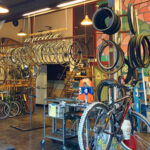For enthusiasts looking to maximize the performance of a 20 Inch Wheel Bike, optimizing components, especially gearing, is crucial. Smaller wheels inherently mean a lower top speed for the same pedaling cadence compared to larger wheel bikes. Therefore, adjustments to gearing and consideration of components become essential to unlock the full potential of these compact bikes. Let’s delve into key areas like bottom brackets, cranks, and chainrings to enhance your 20 inch wheel bike experience.
Optimizing Gearing for Speed on 20 Inch Bikes
Given the smaller circumference of 20 inch wheels, achieving higher speeds requires a different approach to gearing. To compensate for fewer wheel rotations per pedal stroke, increasing the gear ratio is vital. This often involves employing larger chainrings. An often overlooked advantage of using larger chainrings is their gentler impact on the chain. The increased radius reduces the chain’s articulation, leading to less wear and tear, and potentially extending the lifespan of both your chain and sprockets.
Bottom Bracket and Crank Length Considerations
When contemplating larger chainrings for your 20 inch wheel bike, the bottom bracket (BB) and crank selection become important. As mentioned by experts at SickBikeParts, longer cartridge BBs, such as 132mm or 153mm, might be necessary. This is because cranks with less “flare” in their arms, when paired with oversized chainrings, might require a wider BB spindle to achieve optimal chainline and prevent heel strike. While shorter cranks combined with a large chainring might limit your power output in many situations, understanding this trade-off is key to a functional setup. You might find yourself needing to pedal with a slightly wider stance – sometimes referred to as “pedaling like a duck” – depending on the crank and BB combination.
Chainring Size and Ground Clearance
A significant factor to consider when upgrading to larger chainrings on a 20 inch wheel bike is ground clearance. A 60-tooth chainring, for instance, boasts a radius nearing 5 inches. Considering that a 20 inch wheel bike might have a bottom bracket height of only around 8 inches, the clearance between the chainring and the ground becomes minimal. This reduced clearance demands extra caution when navigating obstacles like steps and curbs. Striking the chainring against hard surfaces can lead to damage, so mindful riding is essential.
Front Derailleur Options for Double Chainring Setups
For riders aiming for a versatile double chainring setup, such as a 48-60 combination, a “road triple” front derailleur can be an excellent solution. These derailleurs, typically designed for road bikes with 30-42-52 tooth configurations, are adaptable to larger rings. While road triple derailleurs are optimized for the curvature of 52-54t rings with a 22t difference between rings, they can still accommodate larger rings like a 60T. You may need to mount the derailleur slightly higher on the frame to prevent fouling the teeth of the larger chainring. However, a 12 to 16 tooth difference between chainrings should generally pose no significant issues. A reliable and affordable option to explore is the Shimano 8-speed Triple Bicycle Front Derailleur, readily available online.
In conclusion, enhancing a 20 inch wheel bike for speed and performance involves a careful selection of components, particularly focusing on gearing. Understanding the interplay between chainring size, bottom bracket length, crank choice, and ground clearance is vital. By thoughtfully considering these factors, you can build a 20 inch wheel bike that’s not only fun and compact but also surprisingly efficient and capable.

